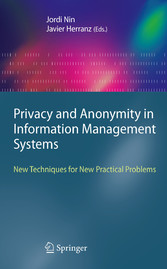Suchen und Finden
Mehr zum Inhalt

Privacy and Anonymity in Information Management Systems - New Techniques for New Practical Problems
Foreword
6
Acknowledgments
8
Contents
9
Contributors
11
Part I Overview
13
1 Introduction to Privacy and Anonymity in Information Management Systems
14
1.1 Background and Motivation
14
1.2 Organization of the Book
15
1.2.1 Part II: Theory of SDC
15
1.2.2 Part III: Preserving Privacy in Distributed Applications
16
2 Advanced Privacy-Preserving Data Managementand Analysis
18
2.1 Introduction
18
2.2 Managing Anonymized Data
20
2.2.1 Randomization-Based Anonymization Techniques
20
2.2.2 Aggregation-Based Anonymization Techniques
22
2.3 Managing Time-Varying Anonymized Data
23
2.3.1 Anonymizing Multiple Releases
24
2.3.2 Anonymizing Data Streams
26
2.4 Privacy-Preserving Data Analysis (PPDA)
27
2.4.1 Privacy-Preserving Association Rule Mining
27
2.4.2 Privacy-Preserving Classification
29
2.4.3 Privacy-Preserving Clustering
33
2.5 Conclusions
35
References
36
Part II Theory of SDC
39
3 Practical Applications in Statistical Disclosure ControlUsing R
40
3.1 Microdata Protection Using sdcMicro
40
3.1.1 Software Issues
41
3.1.2 The sdcMicro GUI
41
3.1.3 Anonymization of Categorical Variables
43
3.1.4 Anonymization of Numerical Variables
52
3.1.5 Disclosure Risk
55
3.1.6 Case Study Using Real-World Data
57
3.2 Tabular Data Protection Using sdcTable
59
3.2.1 Frequency and Magnitude Tables
59
3.2.2 Primary Sensitive Cells
60
3.2.3 Secondary Cell Suppression
61
3.2.4 Software Issues
61
3.2.5 Anonymizing Tables Using sdcTable -- A Guided Tour
63
3.2.6 Summary
68
3.3 Summary
68
References
69
4 Disclosure Risk Assessment for Sample Microdata Through Probabilistic Modeling
72
4.1 Introduction
72
4.2 Disclosure Risk Measures and Their Estimation
75
4.2.1 Notation and Definitions
75
4.2.2 Estimating the Disclosure Risk
76
4.2.3 Model Selection and Goodness-of-Fit Criteria
78
4.3 Complex Survey Designs
80
4.4 Measurement Error Models for Disclosure Risk Measures
81
4.5 Variance Estimation for Global Disclosure Risk Measures
83
4.6 Examples of Applications
85
4.6.1 Estimating Disclosure Risk Measures Under No Misclassification
85
4.6.2 Estimating Disclosure Risk Measures Under Misclassification
90
4.6.3 Variance Estimation and Confidence Intervals
93
4.7 Extensions to Probabilistic Modeling for Disclosure Risk Estimation
93
References
97
5 Exploiting Auxiliary Information in the Estimation of Per-Record Risk of Disclosure
99
5.1 Introduction
100
5.2 Risk Measures and Models for Risk Estimation
101
5.2.1 Superpopulation Models for Risk Estimation with Survey Data
102
5.2.2 SPREE-Type Estimators for Cross-Classifications
104
5.3 Simulation Plan and Data
108
5.4 Risk Estimators and Simulation Results
110
5.5 Comments
116
References
118
6 Statistical Disclosure Control in Tabular Data
120
6.1 Introduction
120
6.2 Tabular Data: Types and Modeling
122
6.2.1 Classification of Tables
122
6.2.2 Modeling Tables
124
6.3 Sensitive Cells and Sensitivity Rules
127
6.3.1 The Threshold Rule for Frequency Tables
127
6.3.2 The (n,k) and p% Rules for Magnitude Tables
127
6.4 Tabular Data Protection Methods
129
6.4.1 Recoding
129
6.4.2 Cell Suppression
130
6.4.3 Controlled Rounding
133
6.4.4 Controlled Tabular Adjustment
134
6.5 Conclusions
136
References
136
Part III Preserving Privacy in Distributed Applications
139
7 From Collaborative to Privacy-Preserving SequentialPattern Mining
140
7.1 Introduction
140
7.2 Problem Statement
142
7.2.1 Mining of Sequential Patterns
142
7.2.2 From Collaborative to Privacy-Preserving Sequential Pattern Mining
144
7.3 The PRIPSEP Approach
145
7.3.1 Collaborative Sequential Pattern Mining
146
7.3.2 From Collaborative to Privacy-Preserving Sequential Pattern Mining
148
7.3.3 Improving the Robustness of the System
157
7.4 Conclusion
158
References
159
8 Pseudonymized Data Sharing
162
8.1 Introduction
162
8.1.1 Security Properties
163
8.1.2 Relevance
165
8.1.3 Related Work
165
8.2 Description of a Pseudonymized Data Sharing System
165
8.2.1 Syntax
166
8.2.2 Security Requirements
167
8.2.3 Notation
167
8.3 Basic Tools
169
8.3.1 Symmetric Encryption with Semantic Security
169
8.3.2 Decisional Diffie--Hellman Assumption
170
8.3.3 Pairings
170
8.3.4 Commutative Encryption
171
8.3.5 Intersection Protocol
172
8.4 A Pseudonym Scheme with Ubiquitous TTP
173
8.5 A Basic Pseudonym Scheme with Light TTP
175
8.6 A Fully Secure Pseudonym Scheme with Light TTP
179
8.7 Conclusion
183
References
183
9 Privacy-Aware Access Control in Social Networks: Issues and Solutions
185
9.1 Introduction
185
9.2 Access Control Requirements
187
9.3 Privacy Issues in OSN Access Control
190
9.4 Review of the Literature
191
9.4.1 Access Control Models
191
9.4.2 Privacy-Aware Access Control
194
9.5 Conclusions and Future Research Directions
197
References
198
Index
200
Alle Preise verstehen sich inklusive der gesetzlichen MwSt.











